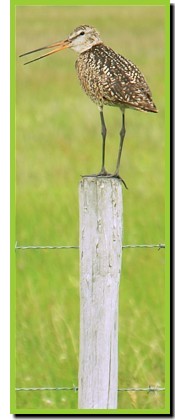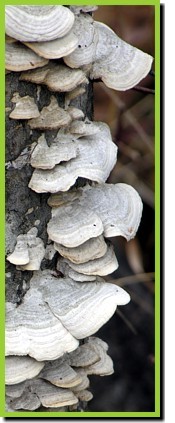2010 Year of Biodiversity Page
BUZZWORD BIODIVERSITY
By Dr. Robert E. Wrigley, Curator, Assiniboine Park Zoo, Winnipeg
Biodiversity is a relatively new word in the conservation arena, and as broadly interpreted refers to the number of species in, or biological richness of, an area. In spite of biological inventories and diverse studies carried out over centuries over much of the planet, our knowledge of the natural world remains in its infancy, particular in distant and hazardous locations (e.g., sea floor). As biologists working in such facilities as museums, universities, provincial/territorial wildlife departments, zoos, aquariums, and conservation organizations, we tend to believe we have a reasonable grasp of the biodiversity in our area or province, but do we really? Could we list the taxa in our district, or even on the properties where we live and work?
 We generally
know what the larger and easily observed species of wildlife are, or
the species in our areas of specialty, but this is just the tip of an
enormous wealth of life forms of which we know literally nothing, with
most species not yet even named and described. This is a serious omission
in our knowledge base if we are truly to protect our local biodiversity,
ecosystems, environment, and specific habitats. When we attempt to modify
species’ populations, distributions (e.g., using exotics for biological
control), habitats, and even genes, to support a species-at-risk or
one of special interest (e.g., crops, commercial resource harvesting
or recreational hunting/fishing), have we any idea what resulting waves
(e.g., effects on numbers and gene frequencies of other biota) reverberate
through the entire ecosystem? And yet at this time of greatest need
for data, taxonomists and ecologists are declining in numbers due to
lack of training and job opportunities (linked to funding priorities).
We generally
know what the larger and easily observed species of wildlife are, or
the species in our areas of specialty, but this is just the tip of an
enormous wealth of life forms of which we know literally nothing, with
most species not yet even named and described. This is a serious omission
in our knowledge base if we are truly to protect our local biodiversity,
ecosystems, environment, and specific habitats. When we attempt to modify
species’ populations, distributions (e.g., using exotics for biological
control), habitats, and even genes, to support a species-at-risk or
one of special interest (e.g., crops, commercial resource harvesting
or recreational hunting/fishing), have we any idea what resulting waves
(e.g., effects on numbers and gene frequencies of other biota) reverberate
through the entire ecosystem? And yet at this time of greatest need
for data, taxonomists and ecologists are declining in numbers due to
lack of training and job opportunities (linked to funding priorities).
These dilemmas set me to thinking what I could contribute to the biodiversity knowledge of my home province – Manitoba. And so I have, with all naivety and modesty, attempted the impossible – a first crack at a biodiversity inventory of this province. I greatly appreciate the contributions to this effort of my colleagues, whom I placed in the uncomfortable and challenging position of coming up with their best estimates. Hopefully others will be encouraged to generate or update inventories in their districts, and to enlarge their concept of local biodiversity and conservation requirements.
Manitoba hosts five major life zones or biomes – Grassland, Boreal Coniferous Forest, Arctic Tundra, Freshwater, and Arctic Marine biomes, plus Aspen Parkland, Eastern Deciduous Forest, and Forest-Tundra transitions. Each of these major biological communities teems with countless numbers of diverse species, from huge whales, Lion’s Mane Jellyfish and the 7-metre Greenland Shark in Hudson Bay to bizarre microscopic life forms in the soil, water and air, and even in and on our bodies. Manitoba is truly buzzing with life during all seasons, even under the snow and ice.
 Glaciers
completely scoured the entire province of life about a dozen times in
the last 1.5 million years – the Pleistocene Ice Age – which
ended only 8,000 years ago. Yet Manitoba currently harbors all five kingdoms
of life (plus Viruses) – Bacteria, Protoctista (microscopic protozoans
and types of algae), Fungi, Plants and Animals. The larger types of animals
and plants have received considerable attention and are more-readily studied,
so their numbers are reasonably well known. However, species estimates
for most other groups are only recently becoming available (see Table
1).
Glaciers
completely scoured the entire province of life about a dozen times in
the last 1.5 million years – the Pleistocene Ice Age – which
ended only 8,000 years ago. Yet Manitoba currently harbors all five kingdoms
of life (plus Viruses) – Bacteria, Protoctista (microscopic protozoans
and types of algae), Fungi, Plants and Animals. The larger types of animals
and plants have received considerable attention and are more-readily studied,
so their numbers are reasonably well known. However, species estimates
for most other groups are only recently becoming available (see Table
1).
There are 635 vertebrate (back-boned) animals, over 31,000 invertebrates (“lower” animals), 2433 plants, 800 lichens (a symbiotic association of fungi and algae), 3000 fungi, and a staggering 36,000 algae in Manitoba; certain of these figures will continue to rise with new studies. There are no numerical estimates for other groups, such as protozoans, bacteria or viruses (The latter two are capable of rapid genetic change.), but they exist in Manitoba in the tens or hundreds of thousands of species or types. While mostly unknown, they form the supporting base of complex food webs, are integral to the cycling of matter and energy, and maintain conditions for life on our Earth.
The diversity of life in Manitoba is always changing over time, both in the short term and over the geological time frame. This occurs due to many factors in Nature, such as varying climate, sea level, species’ distribution, relationships with other species, and even bolide-impact events (i.e., meteorite, asteroid, comet). While earlier times (e.g., 10,000 years ago) witnessed the extinction of dozens of large mammals and birds in our region, only 10 species are officially (CDC Nature Serve) recognized as having been lost from Manitoba during historic times, either from extinction, like the Passenger Pigeon and Rocky Mountain Locust, or extirpation (i.e., survives elsewhere) such as the Swift Fox and Whooping Crane. An additional 25 species have not been detected for several decades and may be extirpated, while many other invertebrates have likely disappeared with the loss of native grassland.
To date, 1.75 million species have been named worldwide, and likely over 100 million species (mostly insects and microscopic forms) await discovery. Yet this is but a tiny fraction of the incredible biodiversity (countless billions) that has evolved over the last 3.6 billion years of life on Earth. So how many species are alive now in Manitoba? No one will ever be able to answer this question, but the number may exceed half-a-million. This rich biodiversity interacts within the various ecosystems of our province, generates our life-support systems, and supports our economy and standard of living. On the local level and worldwide, it is to our great advantage to support the conservation of all wildlife and to protect our environment.
![]()
![]()
Table 1. Recorded or Estimated Biodiversity of Manitoba
This table includes estimates of Manitoba's current biodiversity (#'s of species) as well as historically extinct, extirpated, and exotic species (*). Estimates become less accurate with diminishing body size and lack of research. Species estimates for many other life forms remain unknown.
| ANIMALS |
||||
|
Mammals 88 |
|||
| Birds 391 |
||||
| Reptiles 8 (Snakes 5, Lizard 1, Turtles 2) |
||||
| Amphibians 16 (Frogs 8, Toads 4, Salamanders 4) |
||||
| Fish 132 (freshwater 91, marine 41) |
||||
Arthropods 25,000 (A few groups of these joint-legged invertebrates are listed here.) |
||||
|
Ticks 15 |
|||
| Mites 5000 |
||||
| Lice 500 |
||||
Pseudoscorpions 20 |
||||
| Centipedes 50 |
||||
| Millipedes 10 |
||||
| Crustaceans 200 |
||||
| Spiders 700 |
||||
| Insects 18,000 |
||||
Springtails 200 |
Mayflies 80 |
|||
Stoneflies 40 |
Caddisflies 200 |
|||
Aphids 400 |
Midges 300 |
|||
Thrips 60 |
Mosquitoes 50 |
|||
Butterflies 111 |
Flies 6000 |
|||
Skippers 33 |
Fleas 57 |
|||
Moths 600 |
Leafhoppers 400 |
|||
Beetles 2500 |
Treehoppers 41 |
|||
Ants 81 |
Grasshoppers 68 |
|||
Wasps 5000 |
Crickets 8 |
|||
Bees 225 |
Dragonflies and Damselflies 100 |
|||
Bugs 1400 |
||||
Tunicates 18 |
||||
Sea Squirts 16 |
||||
Larvaceans 2 |
||||
Molluscs 170 |
||||
Snails 94 |
||||
Clams and Scallops 72 |
||||
Chitons 3 |
||||
Tusk Shell 1 |
||||
Rotifers 50 |
||||
Water Bears (Tardigrades) 30 |
||||
Roundworms 3000 |
||||
Flatworms 3000 (land, freshwater and marine) |
||||
Annelid Worms |
||||
Earthworms 120 (including 100 freshwater and terrestrial ones & 20 marine) |
||||
Bristleworms 85 |
||||
| Leeches 24 |
||||
Comb Jellies 3 |
||||
Cnidarians (Jellyfish, Anemones, Soft Corals) 57 |
||||
Sponges 5 |
||||
Arrow Worms 3 |
||||
| PLANTS |
||||
| Vascular Plants (Flowering Plants and Ferns) 1700 (native 1500, exotics 200) |
||||
| Mosses 733 |
||||
| LICHENS 800 |
||||
| FUNGI 3000 |
||||
| PROTOCTISTANS (Unicellular protists) (Unknown, but in the hundreds of thousands) |
||||
|
Algae 36,000 |
|||
| BACTERIA and VIRUSES (Likely in the hundreds of thousands) |
||||
*Species Estimates by:
Dr. Robert Wrigley (mammals, reptiles, amphibian, invertebrates).
Rudolph Koes (birds)
Dr. Ken Stewart and Dr. Bruce Stewart (fishes).
Dr. Terry Galloway (arthropods).
Dr. Eva Pip and Dr. Bruce Stewart (molluscs).
Dr. Bruce Stewart (marine invertebrates).
Dr. David Punter (fungi).
Dr. Diana Bizecki-Rodson (vascular plants).
Dr. Michele Piercey-Normore (mosses, lichens).
Dr. Gordon Robinson (algae).
References
Hamel, Cary (pers. comm.) Nature Conservancy of Canada, Manitoba Region, and the Manitoba Conservation Data Centre.
Stewart, DB, and W.L. Lockhart, 2005, An overview of the Hudson Bay Marine Ecosystem, Can. Fish. Aquat. Sci. 2586. A remarkable inventory of the little-studied ecosystems of Hudson Bay.
Wrigley, R.E. 2007. Zoological Author and Editor, The Encyclopedia of Manitoba. Great Plains Publications, 814 pp. The most-current and comprehensive information on Manitoba biodiversity.
| Return to: IBD Page | NatureNorth.com | Spring | Summer | Fall | Winter |
